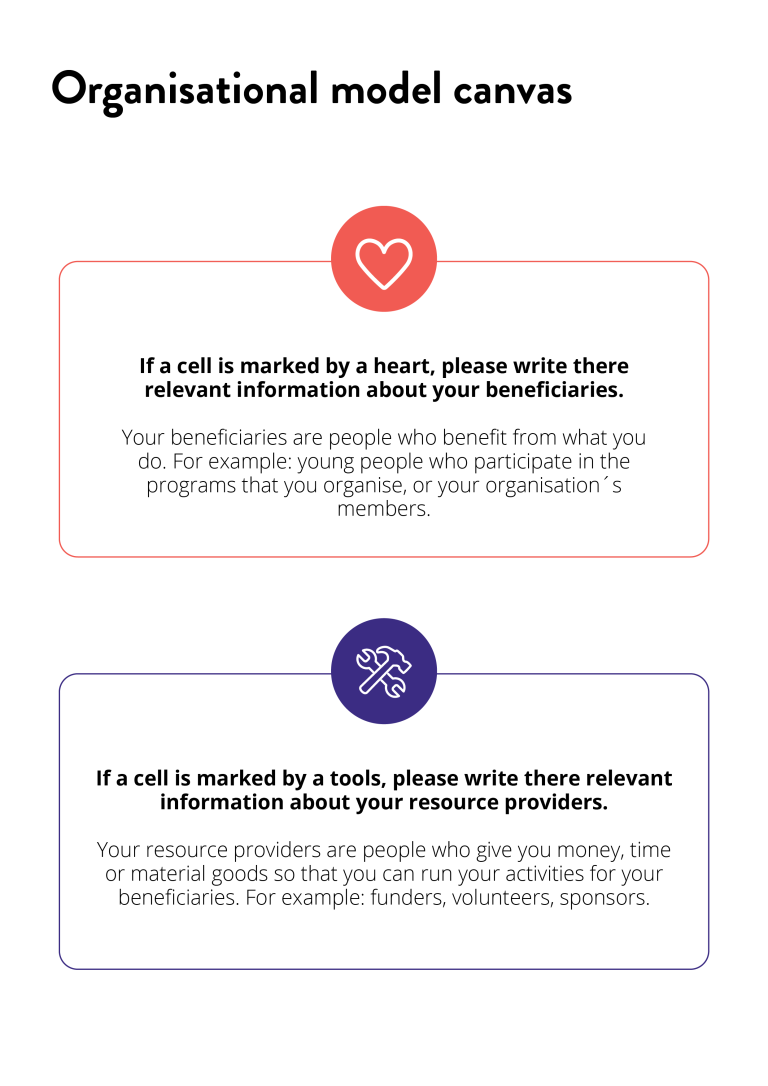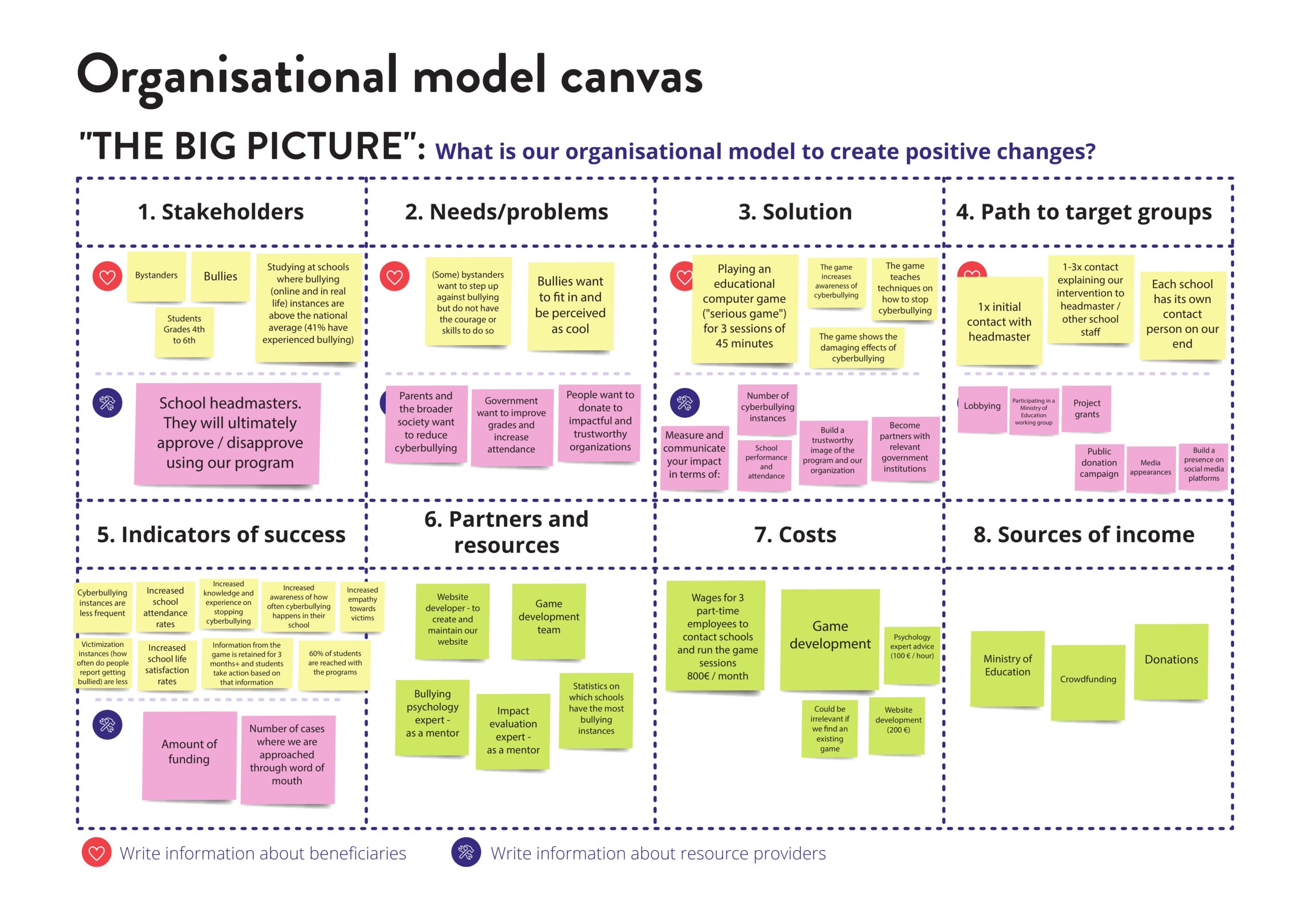An organisational model canvas helps you design and communicate how your organisation will create value for society and attract necessary financial and human resources to keep your work going.
NB! It is partially based on all the other tools.
A canvas… I think I’ve heard about it. It’s a business model canvas, right?
Yes and no!
The business model canvas is a widely used tool for strategic management. Its main purpose is to help develop new business models, as well as document existing ones.
Many canvases have been developed, but Alexander Osterwalder’s conceptualization is the most common one. It’s a chart that consists of nine cells and helps people understand connections between them: key partners, key activities, key resources, value proposition, customer relationships, channels, customer segments, cost structure, and revenue streams. It helps the entrepreneurs visualize and communicate your business model or explore new ones.
You may wonder why you can’t use the same tool for your organization.
A business model canvas is indeed a common tool for businesses. However, it’s usually not the best for (youth) organizations or other NGOs. Any business has to generate profit as its most important goal – that’s how the for-profit enterprises measure their success. A business model canvas helps them plan how to do what they do even better to generate bigger profits yet.
On the other hand, when you think about youth organizations or social enterprises working with young people, their first aim is to make a change. It can be for their members or the wider society, but money is mostly used as a means, not a goal by itself. Also, organizations’ opportunities, capacities, etc. can be quite different from those of for-profit companies, so it wouldn’t make sense to use the same approach for both of them.
So… how does the canvas look like for the organisations that create positive impact?
You may wonder why you can’t use the same tool for your organization.
The organisational canvas is a concise model of your organisation! It helps you to see for yourself and show to others what and how you would like to achieve the goals of your organisation. It combines information from all the previous tools with the facts about your organisation’s finances and partnerships.
Importantly, the organisational canvas helps you to analyse separately your beneficiaries as well as the stakeholders who provide you with resources to achieve your impact goals. After filling in the canvas you can see clearly your strengths and weaknesses in terms of management and content work of your organisation.
Sounds cool!
How does the tool look like?

Umm… what are the heart and tools pictograms about?

Looks complicated. Quite many steps to take.
Could you walk me through it?
Sure! You can watch the video to get an idea of what the tool is about or continue reading after the video player.
Could you give some more advice on how to use this?
Of course. The detailed instructions are as follows.
1. Fill in the information about all the cells either the way they are at the moment (if your organization already exists) or how you imagine your organization is in the future (if you’re in the process of establishing a new initiative).
2. Start analyzing the situation (if your organization already exists) or testing the assumptions of whether the reality would really look like this (if you’re in the process of establishing a new initiative).
NB! Feel free to make adjustments to the tool when necessary.
Variations of use
Variations in the level of preparations.
LIGHT. Fill in the information according to your and your team’s knowledge.
MEDIUM to ADVANCED. As preparatory work, use all the analytical tools related to the impact dimension (problem tree, goal tree, etc. leading to the Theory of Change) and other documents that your organization uses to run its activities (e.g. a communication plan).
I think I’m starting to get it now.
Could I see an example just to be sure?
Of course. Here is an example about a social enterprise that aims to increase the well-being of university students.
And here’s an example of a cyber-bullying prevention programme.

Okay thanks.
I understand how it works now but I’m still not sure if I should use this for my project or not.
When and why should I use the tool?
Here’s why it can be super useful.
The organizational canvas is a concise model of your organization showing the link between your impact, activities, and needed resources! It helps you to see for yourself and show to others who you are and if you are moving in the right direction. The short, detailed, and visual overview of your organization is helpful to understand what your aims are, who the stakeholders are, what your value proposition is, where your resources come from, etc.
When you fill in the canvas before starting a new organization, you can use it to clearly map out what the organization will do and what it will need. If your organization is already established, the canvas is useful for analyzing and improving the management of the organization, helping to point out strengths, weaknesses, and opportunities. You can create the canvas from scratch or by using information from other tools.
Have you ever found it difficult to give a clear and brief overview of your organization to other people (e.g. new team members, funders, or even your friends)? The canvas can also be a wonderfully useful communication tool, showing everything that’s important about your organization on one page.
Here’s what the tool can help you with.
Why use it?
☑ To find out whether the way you’re combining or planning to combine all the activities makes sense.
☑To find out what are the essential components of your organization to keep, improve or change.
☑ To help you explain the work of your organization to others.
And here are some hints about the perfect moments when to use it
☑ If you’re planning to establish a new organization, the canvas will help you to really imagine what would be needed to run the activities successfully.
☑ If your organization already exists, you can first fill in the canvas according to your current situation and then use it as a tool to start improving your activities and impact (or communicating these clearly and briefly to others).
